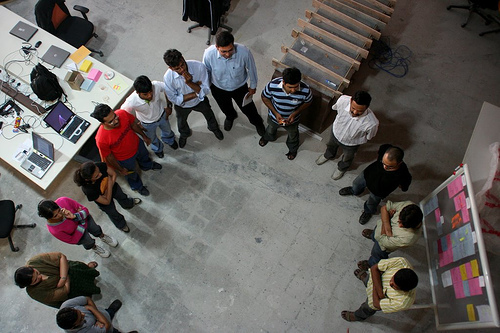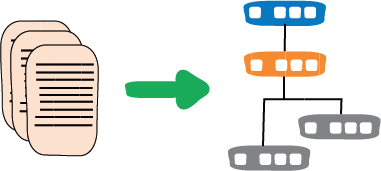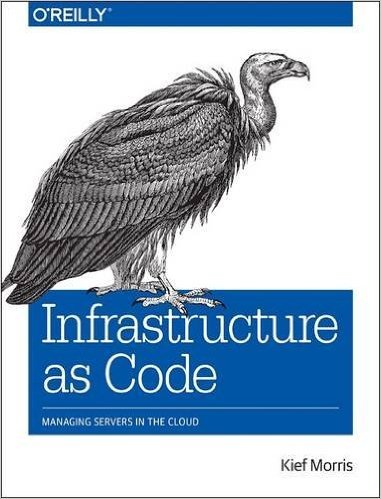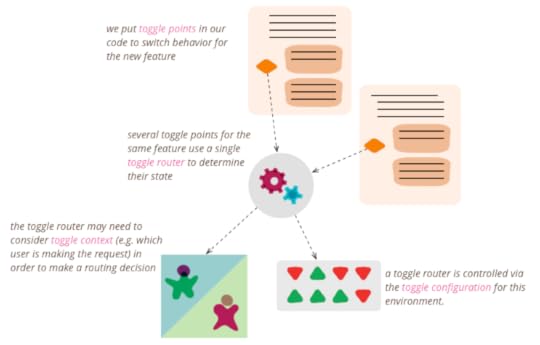Martin Fowler's Blog, page 29
March 8, 2016
Overhaul to "It's not just standing up"

Jason Yip has overhauled his definitive article on running stand-up
meetings. The update incorporates his latest understanding on what separates a
valuable meeting from a waste of time, emphasizing the "walk-the-board" style of
stand-up.
March 1, 2016
Bliki: InfrastructureAsCode
Infrastructure as code is the approach to defining computing and network
infrastructure through source code that can then be treated just like any software
system. Such code can be kept in source control to allow auditability and
ReproducibleBuilds, subject to testing practices, and the full discipline of
ContinuousDelivery. It's an approach that's been used over the last decade to
deal with growing CloudComputing platforms and will become the dominant way
to handle computing infrastructure in the next.

I grew up in the Iron
Age, when releasing a new server application meant finding some physical hardware to
run it on, configuring that hardware to support the needs of the application, and
deploying that application to the hardware. Getting hold of that hardware was usually
expensive, but also long winded, usually a matter of months. But now we live the Cloud
Age, where firing up a new server is a matter of seconds, requiring no more than an
internet connection and a credit card. This is a dynamic infrastructure where software
commands are used to create servers (often virtual machines, but can be installations on
bare metal), provision them, and tear them down, all without going anywhere near a
screwdriver.
Practices
Infrastructure as Code is based on a few practices:
Use Definition Files: all configuration is defined in executable configuration
definition files, such as shell scripts, Ansible playbooks, Chef recipes, or Puppet
manifests. At no time should anyone log into a server and make on-the-fly
adjustments. Any such tinkering risks creating SnowflakeServers, and so should only be done
while developing the code that acts as the lasting definition. This means that applying
an update with the code should be fast. Fortunately computers execute code quickly,
allowing them to provision hundreds of servers faster than any human could type.
Self-documented systems and processes: rather than instructions in documents
for humans to execute with the usual level of human reliability, code is more precise and
consistently executed. If necessary, other human readable documentation can be
generated from this code.
Version all the things: Keep all this code in source control. That way every
configuration and every change is recorded for audit and you can make
ReproducibleBuilds to help diagnose problems.
Continuously test systems and processes: tests allow computers to rapidly find many
errors in infrastructure configuration. As with any modern software system, you can
set up DeploymentPipelines for your infrastructure code which allows you to practice
ContinuousDelivery of infrastructure changes.
Small changes rather than batches: the bigger the infrastructure update, the more
likely it is to contain an error and the harder it is to detect that error,
particularly if several errors interact. Small updates make it easier to find errors
and are easier to revert. When changing infrastructure FrequencyReducesDifficulty.
Keep services available continuously: increasingly systems cannot afford downtime
for upgrades or fixes. Techniques such as BlueGreenDeployment and
ParallelChange can allow small updates to occur without losing availability
Benefits
All of this allows us to take advantage of dynamic infrastructure by starting up new
servers easily, and safely disposing of servers when they are replaced by newer
configurations or when load decreases. Creating new servers is just a case of running
the script to create as many server instances as needed. This approach is a good fit
with PhoenixServers and ImmutableServers


Kief Morris's book is due to be published later this year. Between now and March 18
is due to be published later this year. Between now and March 18
ThoughtWorks is offerring three sample chapters as a free download.
Using code to define the server configuration means that there is greater consistency
between servers. With manual provisioning different interpretations of imprecise
instructions (let alone errors) lead to snowflakes with subtly
different configurations, which often leads to tricky faults that are hard to debug.
Such difficulties are often made worse by inconsistent monitoring, and again using code
ensures that monitoring is consistent too.
Most importantly using configuration code makes changes safer, allowing
upgrades of applications and system software with less risk. Faults can be found and fixed more
quickly and at worst changes can be reverted to the last working configuration.
Having your infrastructure defined as version-controlled code aids with compliance
and audit. Every change to your configuration can be logged and isn't susceptible to
faulty record keeping.
All of this increases in importance as you need to handle more servers, making
infrastructure as code a necessary capability if you're moving to a serious adoption of
microservices. Infrastructure as Code techniques scale
effectively to manage large clusters of servers, both in configuring the servers and
specifying how they should interact.
Further Reading
My colleague Kief Morris has spent the last year working on
a book that goes into more detail about infrastructure as code, which is
that goes into more detail about infrastructure as code, which is
currently in the final stages of production. The list of practices is taken directly
from this book.
Acknowledgements
This post is based on the writing and many conversations with Kief Morris.
Ananthapadmanabhan Ranganathan, Danilo Sato, Ketan Padegaonkar, Piyush
Srivastava, Rafael Gomes, Ranjan D Sakalley, Sina Jahangirizadeh, and Srivatsa Katta
discussed drafts of this post on our internal mailing list.
Share:



if you found this article useful, please share it. I appreciate the feedback and encouragement
February 22, 2016
Basics of Web Application Security: Bind Parameters for Database Queries
Cade and Daniel now move onto a simple but vital technique: ensuring you use
parameter binding in your database queries to ensure your database doesn't suffer
the ravages of Little Bobby Tables.
February 8, 2016
Final part of Feature Toggles

Pete finishes his article on feature toggles with some advice on where to place
toggle points and managing the carrying cost of toggles.
February 7, 2016
photostream 94
February 5, 2016
Working with feature-toggled systems

Pete offers some advice on working with feature-toggled systems, including
dealing the issue of how to select toggle combinations for testing.
February 3, 2016
Basics of Web Application Security: Encode HTML output
In the second part of their evolving article, Cade and Daniel describe the
danger of sending malformed data to the browser, including techniques that avoid turning a Supreme
Court justice into an attack vector.
February 2, 2016
Configuration of Feature Toggles
January 28, 2016
Implementation techniques for feature toggles

Feature Toggles seem to beget rather messy Toggle Point code, and these Toggle
Points also have a tendency to proliferate throughout a codebase. It's important to
keep this tendency in check for any Feature Toggles in your codebase, and critically
important if the toggle will be long-lived. In this installment, Pete covers a few
implementation patterns and practices which help to reduce this issue.
The Basics of Web Application Security
Modern web development has many challenges. Of course, you need to write code
that fulfills customer functional requirements. It needs to be fast. Further you
are expected to write this code to be comprehensible and extensible.
Somewhere, way down at the bottom of the list of requirements, behind, fast,
cheap, and flexible is “secure”. That is, until something goes wrong, until the
system you build is compromised, then suddenly security is, and always was, the
most important thing.
Specialized techniques, such as threat analysis, are increasingly recognized as
essential to any serious development. But Cade Cairns and Daniel
Somerfield explore how security can be significantly enhanced with some basic
practices which every developer can and should be doing as a matter of course.
Martin Fowler's Blog
- Martin Fowler's profile
- 1104 followers




